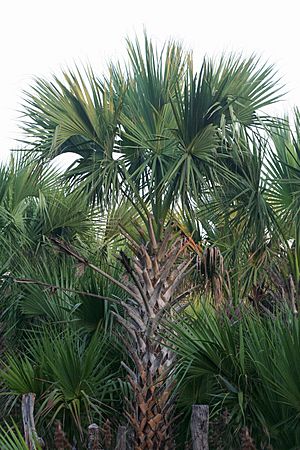Mexican palmetto facts for kids
Quick facts for kids Mexican palmetto |
|
|---|---|
 |
|
| Conservation status | |
| Scientific classification | |
| Genus: |
Sabal
|
| Species: |
mexicana
|
 |
|
| Natural range | |
| Synonyms | |
|
|
The Sabal mexicana, often called the Mexican Palmetto or Rio Grande Palmetto, is a type of palm tree. It grows naturally in the southern parts of North America. Its scientific name, mexicana, is Latin for "from Mexico". Other common names include Texas palmetto and palmetto cabbage.
Contents
What Does the Mexican Palmetto Look Like?
The Mexican Palmetto is a very tall tree. It can grow to be about 12 to 18 meters (40 to 60 feet) high. That's like a four-story building! Its main stem, called a trunk, can be 12 to 15 meters (40 to 50 feet) long. It can also be about 30 centimeters (1 foot) wide.
This palm has large, fan-shaped leaves called fronds. Each frond can be 1.5 to 1.8 meters (5 to 6 feet) wide. They are attached to the trunk by smooth stems called petioles. These stems are about 90 to 120 centimeters (3 to 4 feet) long and do not have spines.
The tree also produces long spikes of small flowers. These spikes can be 1.2 to 1.8 meters (4 to 6 feet) long. The flowers are bisexual, meaning they have both male and female parts. After the flowers, the tree grows small, round fruits called drupes. When they are ripe, these fruits are black and about 12 millimeters (0.5 inches) across.
Where Does the Mexican Palmetto Grow?
The Mexican Palmetto grows in many places. Its natural home stretches from South Texas in the United States down to Nicaragua. You can find it along both the Gulf Coast and the Pacific Coast. It is one of the most common palm trees in Mexico. There, it likes to grow in drier, low-lying areas.
Some people think this palm used to grow even further north in Texas. This idea comes from old records and a small group of these palms that grow far away from the main group. Also, planted trees often start growing on their own in new areas.
It can be hard to tell if a Mexican Palmetto in Texas grew there naturally. This is because many people plant them as ornamental trees. However, there are at least two places in Texas where these palms are truly wild. One big area is the 557-acre Sabal Palm Sanctuary. It is located near Brownsville, Texas, right by the Rio Grande river. Another smaller group grows near Vanderbilt, Texas, along Garcitas Creek.
How Do People Use the Mexican Palmetto?
The Mexican Palmetto is a very useful tree.
- For Gardens: People often plant it in their gardens because it looks grand and strong. It can handle dry weather and cold temperatures down to USDA Zone 8.
- For Building: The wood of this palm is very strong. It does not rot easily and is resistant to shipworms. This makes it great for building things like wharf pilings (poles that support docks) and fence posts.
- For Crafts: The large leaves are used for thatching roofs. They are also used to make straw hats.
- For Food: The fruits (drupes) of the Mexican Palmetto can be eaten. The inner part of the growing bud, called the palm heart, is also eaten.
Images for kids
See also
 In Spanish: Palmito de México para niños
In Spanish: Palmito de México para niños






